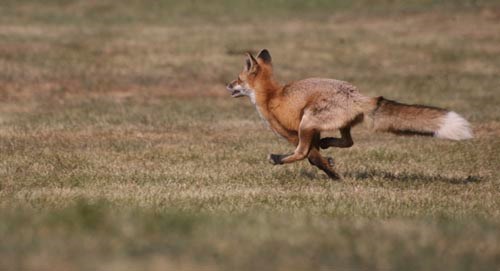Winds were howling on the morning of Sept. 12, something that worried everyone involved in the fox release. Putting added stress on already scared animals, taking their first steps back into the wild isn't something anyone is ready for. So the release was rescheduled to the Sept. 26, as fingers were crossed that the winds wouldn't return.
The drive out to the Recoup and Release is a beautiful one. The trees in White Bear and Kenosee Lake are getting ready for the fall as well. The leaves are all changing to numerous different colours and have begun falling to the ground for winter's arrival. It is important to get the foxes back into the wild before snow falls, as maneuvering their crates on icy land isn't quite desirable, nor is releasing them to harsh climates.
A few months back, the Observer ran a story about Moose Mountain Recoup and Release. The story mainly focused on the recoup section of the name, but as a new season approaches, the releases slowly begin.
Pulling up to the destination, Cheryl Winkler, of Moose Mountain R &R greets us. She is quite a pleasant lady with a heart of gold. She has dedicated her time, life and savings to the well being of wildlife. It is an unpaid 24-hours a day, seven-days a week commitment.
This set of foxes have been raised by a fox foster mom, Rose, who has been at the centre for several years. Although Rose is a very happy animal, she struggles with vision problems and will never be released into the wild. Knowing that, Winkler has provided a safe and healthy home for her to live out the remainder of her years, and in return Rose has dedicated her mothering skills to orphaned babies.
During her time without kits, Rose is quite used to Winkler and her family, but has no difficulty switching back into gear when new litters are placed in her pen. She is quite a protective mom and takes the job very seriously. Natural maternal instincts are apparently true in animals, to the same magnitude they are in human mothers.
Even though Rose has become close to these babies in the past few months, the split mirrors what would occur in her natural habitat as well. Once a baby matures, mothers often separate from them, allowing them to start their own lives.
By six-months-old, baby fox are hard to differentiate from their parents and are ready to leave their natal area in order to search for their unique territory. And by 10 months they are fully grown and able to breed.
Foxes are usually seen on their own, as they prefer to hunt this way. This is not to say they spend all day like this, as they are known to form pairs and are generally monogamous. The pair travel, hunt and feed independently but are known to meet up randomly to play and groom each other. It also isn't completely uncommon for one of the breeding pair's offspring to stick around. These foxes are often known as helpers.
As for the fox leaving Moose Mountain R and R, they are six-months-old and ready to start a new chapter in their lives. Although Winkler always worries about her rehab graduates, she knows she has done the right thing by not letting them get to be too human reliant and friendly. A fox belongs in the wild, as do birds of prey, skunks, raccoons, squirrels, fawns and every other animal which has walked through her property.
If you encounter an animal in the wild it is important to keep your distance, admire from afar, while allowing nature to take its course.
And as for Rose, she will be -back to her normal life in a few weeks, happily greeting Winkler with a wagging tail at meal time.



